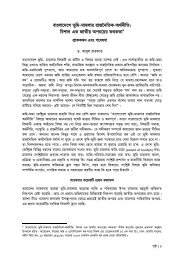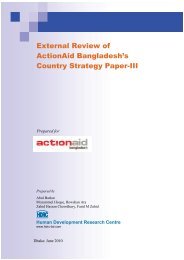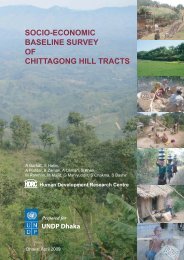08. Costing Essential Services Package An Issue Paper
08. Costing Essential Services Package An Issue Paper
08. Costing Essential Services Package An Issue Paper
You also want an ePaper? Increase the reach of your titles
YUMPU automatically turns print PDFs into web optimized ePapers that Google loves.
<strong>Costing</strong> <strong>Essential</strong> <strong>Services</strong> <strong>Package</strong>: <strong>An</strong> <strong>Issue</strong> <strong>Paper</strong> 17<br />
8. Many equipment and supplies have joint- use across the major areas and sub-areas of<br />
ESP. PPC’s cost estimate is not tuned to the appropriate apportionment of joint costs by<br />
areas and sub-areas of ESP. This makes working-out of average and marginal cost by<br />
sub-areas difficult. It is almost impossible to answer some important questions relating to<br />
the technical efficiency, allocative efficiency, and measurement of cost-effectiveness.<br />
9. In terms of capital item and long term supplies it is insufficient to simply average the inputs<br />
over the period or use the year-1 disbursement pattern. A more accurate (but not that<br />
costly) approach would have been deployed to estimate the useful life or expected life or<br />
remaining life of each durable item and annualize (as discussed in section 1) before<br />
aggregating inputs.<br />
10. According to the Health and Population Sector Strategy (HPSS), the services under HPSP<br />
should be responsive to clients’ needs – especially those of children, women and the poor<br />
(GoB 1998a: 5). PPC’s ESP costing is unable to provide information about relative share<br />
of public sector expenditure to those classes and segments (this is a deviation from equity<br />
consideration of public health benefits). In this connection, some sort of benefit incidence<br />
studies would be useful.<br />
5.2 <strong>Costing</strong> ESP: HEU’s exercise<br />
Health Economics Unit conducted a major ESP costing exercise in 1997 titled “Development of<br />
a simulation model for the costing of the essential package of services in Bangladesh”. The<br />
main purpose of HEU’s ESP Cost study was to estimate a model and conduct simulation<br />
exercises using data on costs of ESP components and seek answers to the relevant questions<br />
pertaining to the effects and efficiency of reorganization and integration of the health sector.<br />
Since the aim was to work out a simulation model in which the total cost of the package is<br />
calculated as function of a set of assumptions regarding gains in efficiency, rates of utilization –<br />
a disaggregated data set on the cost of each ESP component was needed. Review of<br />
methodological issues pertaining to this study was done by Ensor (1999) and Howlader (1998).<br />
The salient points of the ESP <strong>Costing</strong> exercise conducted by HEU in line with the purpose of<br />
this issue paper are presented below.<br />
Methodologically, the HEU study identified the following steps in costing ESP:<br />
� Estimate cost of the existing delivery system,<br />
� Work out the need for additional costs (for each program) for the next five years,<br />
� Estimate the proportion of the existing delivery costs which can be allocated to the project<br />
under consideration,<br />
� Estimate ESP cost of non-ESP components, and distribute the same among the different<br />
areas of ESP (RHC, CHC, CDC, LCC, BCC),<br />
� Compute the proportion of overhead and super-overhead costs which should be allocated to<br />
each vertical program,<br />
� Calculate variable costs based on existing utilization rates and the target population (also<br />
ascertain the degree of association between the rate of utilization and the target population),<br />
� Ensure that the model allows changing in ESP cost estimates with the changes in<br />
assumptions in the future (e.g. changing efficiency gains, allocative re-priorities, etc).<br />
� Refine cost estimates using the above steps based on some useful pertinent information<br />
obtained from secondary sources (e.g., costing study conducted by UNICEF in two thanas).






